Understanding the Cost Factors Behind Lifting Magnets and Their Price Variations
Understanding Lifting Magnet Prices Factors and Insights
Lifting magnets are invaluable tools in various industrial applications, particularly in manufacturing, construction, and recycling sectors. They are designed to lift and transport ferrous materials like steel and iron, contributing significantly to efficiency and safety in operations. However, like any specialized equipment, the price of lifting magnets can vary widely based on several factors. This article explores the components that influence lifting magnet prices.
1. Type of Lifting Magnet
There are several types of lifting magnets available on the market, each designed for specific applications. The most common types include permanent magnets, electromagnetic magnets, and battery-operated magnets.
- Permanent Magnets These are generally less expensive because they do not require an electrical supply to function. The cost can range from $100 to $500, largely depending on the lifting capacity and size. - Electromagnetic Magnets These are often more costly due to their complexity and the need for a power source. Prices can range from $500 to over $3,000, influenced by factors such as voltage, lifting capacity, and additional features like safety shut-off systems. - Battery-Operated Magnets These provide portability and flexibility for different locations but usually come at a higher price due to the advanced technologies involved. Their prices can start around $1,000 and can go up to $5,000 or more.
The lifting capacity of a magnet, measured in tons, is a crucial determinant of price. Magnets designed to lift heavier loads typically use more advanced materials and require robust construction, driving up their costs. For instance, a lifting magnet with a capacity of 1 ton may cost significantly less than one with a 10-ton capacity. Higher capacity magnets often range from $1,500 to $10,000, depending on the type and brand.
3. Brand and Quality
lifting magnet price

The brand of a lifting magnet can significantly influence its price. Established brands known for durability and reliability generally command higher prices. However, they often provide better support, warranties, and quality assurance. Conversely, lesser-known brands may offer lower prices but could compromise on quality and safety, which may result in increased long-term costs due to failures or replacements.
4. Special Features and Customization
Many lifting magnets come with additional features designed to enhance usability and safety. These may include
- Safety Features Automatic shutdowns when not in use or when overloading occurs can add to the cost. - Control Systems Advanced controls for better precision in lifting and placement can also increase the price. - Custom Sizes and Designs If a factory or operation has unique requirements, custom-built magnets can significantly increase the cost due to specialized manufacturing processes.
5. Market Demand and Economic Factors
Market demand can also play a role in pricing. In times of high demand for industrial equipment, prices may rise. Conversely, during economic downturns, prices may stabilize or decrease. Tariffs, trade policies, and the cost of raw materials can further impact lifting magnet costs.
Conclusion
When considering the purchase of lifting magnets, understanding the various factors influencing prices can help businesses make informed decisions. Each application will have different requirements, and investing in the right type and quality of lifting magnet is crucial for maximizing efficiency and ensuring safety. Budgeting for these essential tools means considering not just the initial purchase price but also the long-term value they bring to operations. By analyzing the factors mentioned above, businesses can select the right lifting magnet that meets their needs without compromising on quality or safety.
-
4000 lb Gantry Crane | Adjustable, Heavy-Duty Lifting SolutionsNewsAug.31,2025
-
Portable 2000 lb Gantry Crane | Heavy-Duty & AdjustableNewsAug.30,2025
-
Versatile Lifting Solutions with Gantry and Overhead CranesNewsAug.29,2025
-
The Versatile Mobile Gantry Crane SolutionNewsAug.29,2025
-
Reliable Movement with Heavy Machinery Skates and RollersNewsAug.29,2025
-
Reliable Lifting Performance with 2000 lb Gantry Crane and 2 Ton Overhead SystemsNewsAug.29,2025
-
Maximize Lifting Efficiency with PML Magnetic LiftersNewsAug.29,2025
